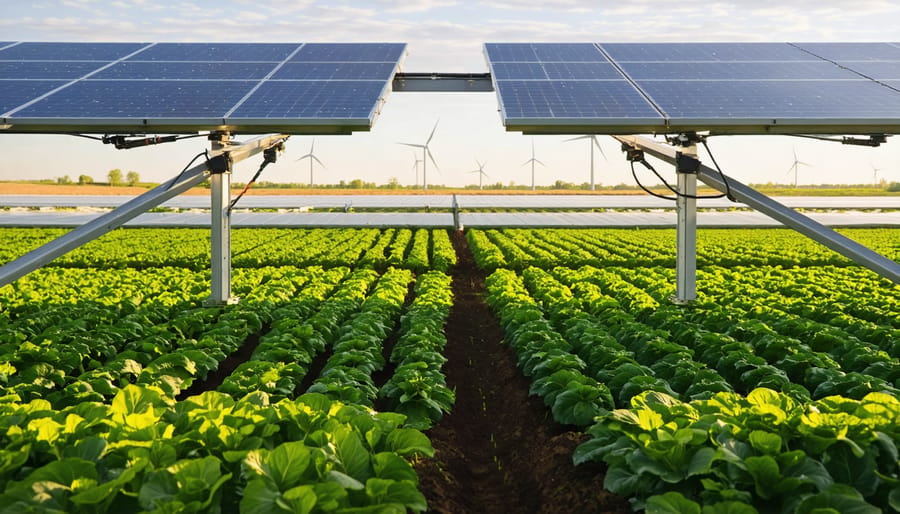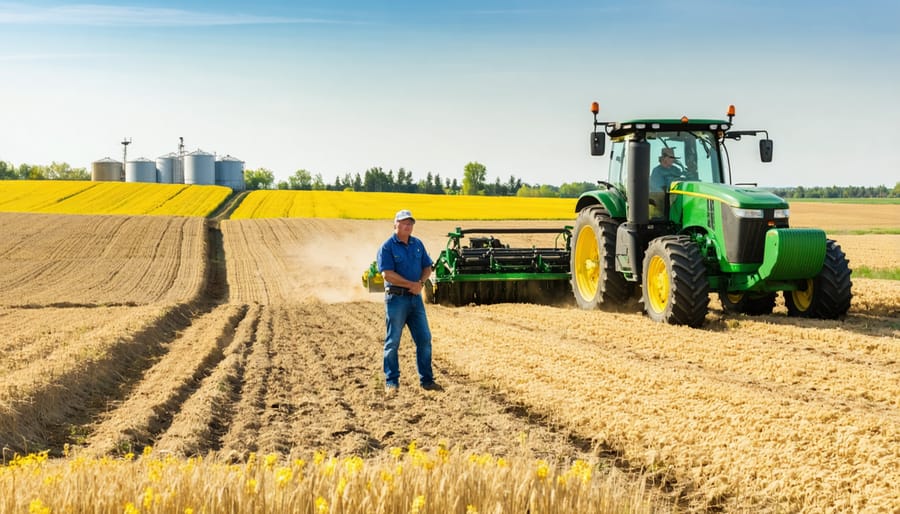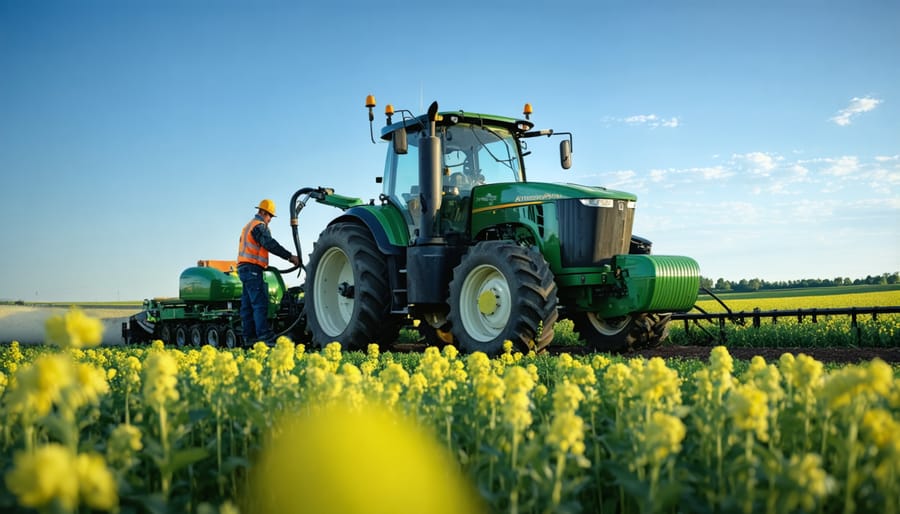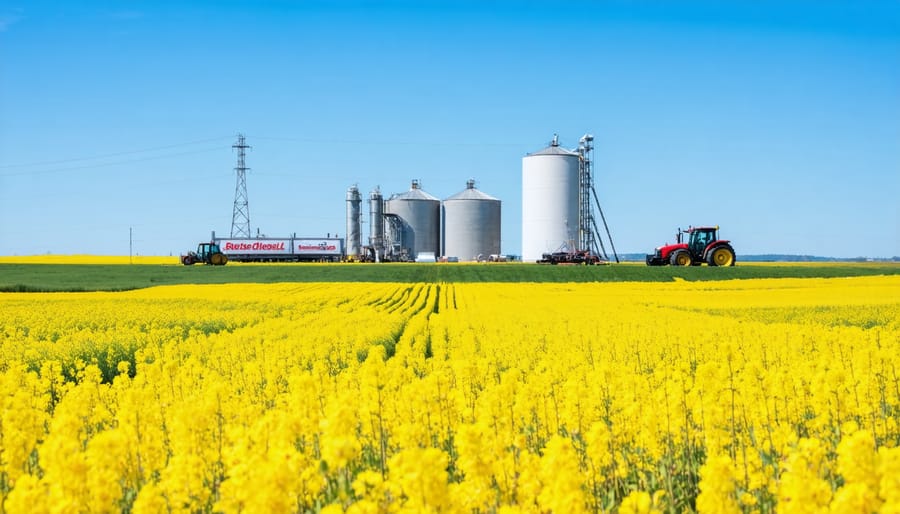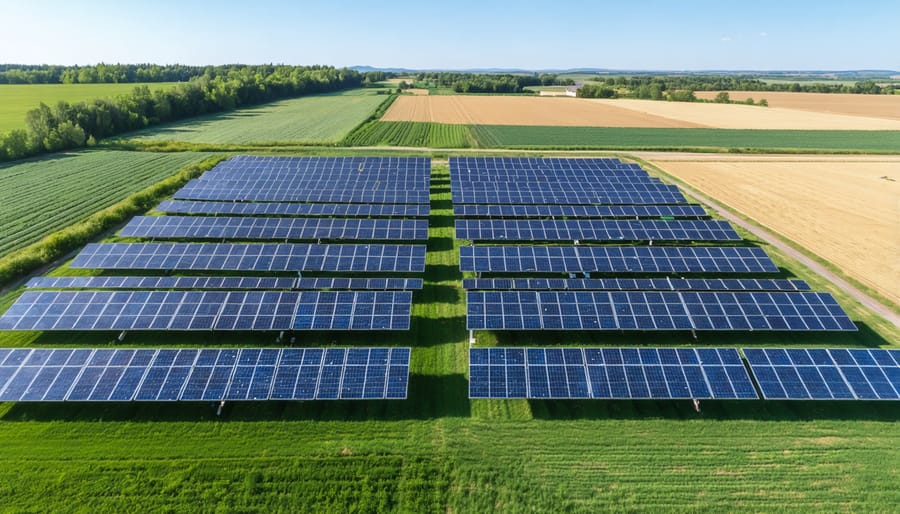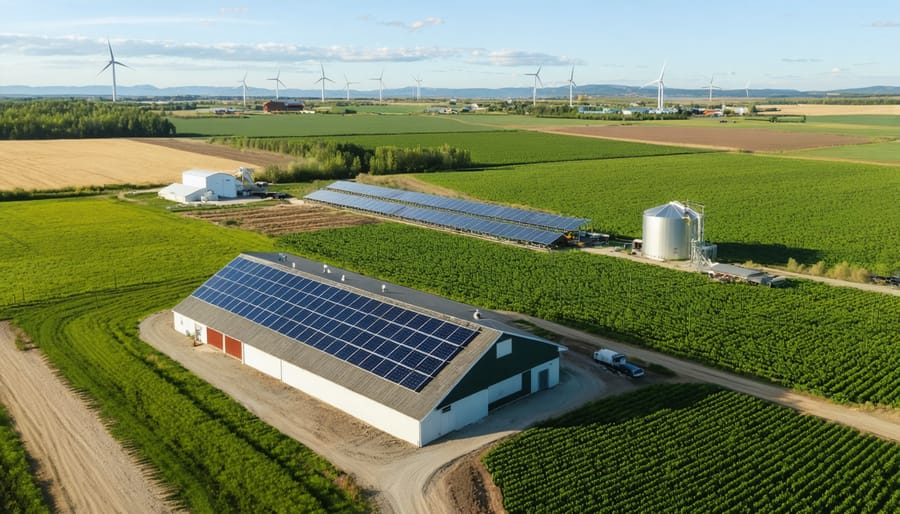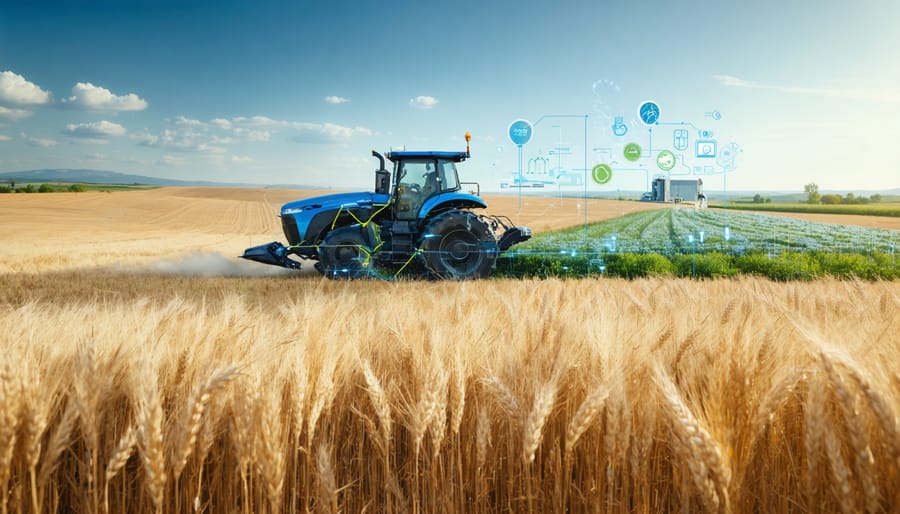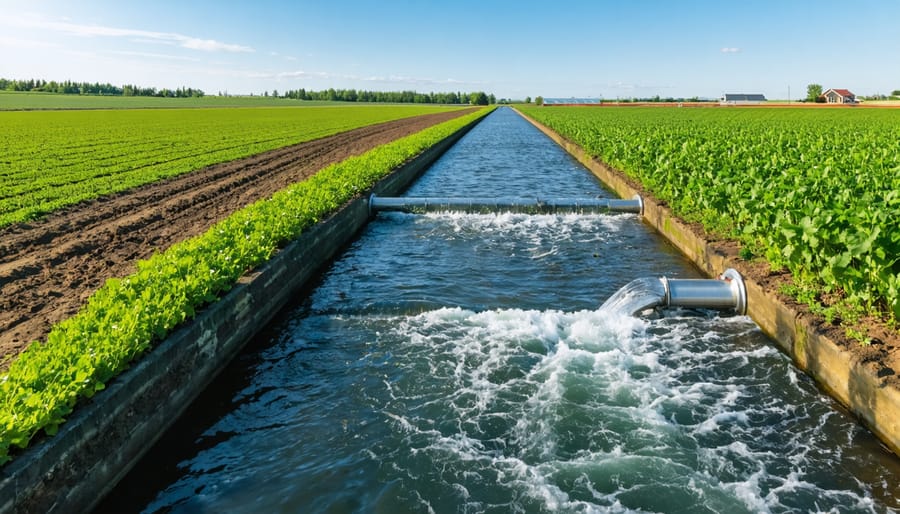Transforming Alberta’s agricultural landscape through renewable energy integration has become not just an environmental imperative but a powerful economic opportunity for farmers. Across the province’s 50.5 million acres of farmland, innovative producers are harnessing solar, wind, and biomass technologies to slash operating costs while building resilient, sustainable operations. Recent data from Alberta Agriculture shows that farms implementing integrated renewable systems reduce their energy expenses by an average of 60% within the first three years, while qualifying for up to $50,000 in provincial clean energy grants. As global markets increasingly demand sustainably produced food, local farmers who combine traditional agricultural expertise with renewable energy solutions are positioning themselves at the forefront of Canada’s agricultural evolution. This integration represents more than just an energy transition – it’s a strategic investment in the future of farming, offering Alberta producers both immediate cost savings and long-term market advantages in an increasingly sustainability-focused global economy.
Why Alberta Farms Are Perfect for Renewable Energy
Solar Potential in Southern Alberta
Southern Alberta boasts some of the highest solar potential in Canada, receiving over 2,300 hours of sunshine annually – more than any other prairie region. This abundant solar resource makes the area ideal for renewable energy projects, particularly when combining solar panels with agriculture. The region’s flat terrain and existing electrical infrastructure provide excellent conditions for solar installations.
Local farmers are increasingly recognizing these advantages, with many reporting successful integration of solar systems into their operations. The Medicine Hat area, nicknamed “Gas City,” is now emerging as “Solar City” due to its exceptional solar resources and growing number of agricultural solar installations.
The region’s climate offers unique benefits for solar energy generation, with cold, clear winter days actually improving panel efficiency. Even during shorter winter days, the reflection from snow cover can enhance energy production. Additionally, the seasonal alignment of peak solar production with irrigation needs makes solar particularly valuable for Alberta farmers, helping offset high summer electricity costs while supporting sustainable farming practices.
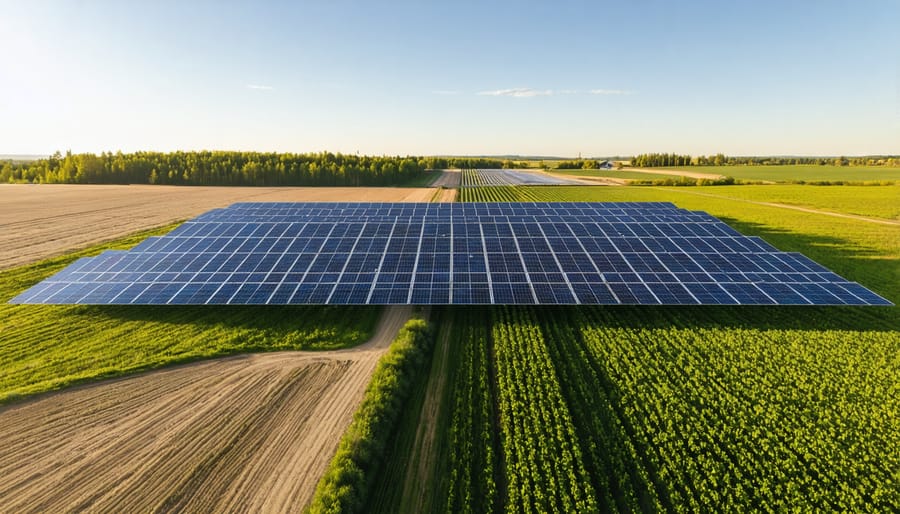
Wind Energy Corridors
The strategic placement of wind turbines can significantly boost your farm’s energy independence. Here in Alberta, we’re blessed with some of the country’s most reliable wind patterns, particularly along the southern corridor where wind farms in Alberta have shown remarkable success. The most productive zones typically fall within the Pincher Creek and Crowsnest Pass regions, where average wind speeds consistently reach 20-25 kilometres per hour.
For optimal wind energy harvesting, consider elevating turbines on ridge lines or open fields where wind flow isn’t obstructed by buildings or tree lines. Many Alberta farmers have found success by placing smaller turbines at heights of 30-40 metres, which capture steady winds while minimizing visual impact on the landscape.
Local meteorological data suggests that winter months offer the highest wind energy potential, conveniently aligning with peak farming energy demands for livestock facilities and storage units. Working with neighbouring farms to create wind energy corridors can maximize efficiency and share infrastructure costs, making this renewable option more accessible for everyone in our farming community.
Practical Integration Methods for Your Farm
Solar Solutions for Farm Operations
Solar technology offers Alberta farmers multiple pathways to reduce operational costs while supporting sustainable agriculture. From powering irrigation systems to maintaining temperature control in greenhouses and storage facilities, solar solutions can be tailored to meet diverse farm needs.
Many Alberta farmers have found success with grid-tied solar systems, which can offset electricity costs during peak summer months when both solar production and farming operations are at their highest. For example, the Henderson family farm near Lacombe reduced their annual electricity costs by 65% after installing a 25-kilowatt system on their dairy barn roof.
Solar-powered irrigation systems have proven particularly effective for market gardens and specialized crop operations. These systems can be designed to match specific water requirements, with some farmers reporting water savings of up to 30% through precise timing and distribution control.
Cold storage facilities, essential for preserving harvest quality, can benefit significantly from solar integration. The consistent daytime power generation aligns well with cooling demands, helping maintain optimal storage conditions while reducing energy costs.
For remote operations without grid access, solar-battery systems provide reliable power for essential equipment, including electric fencing, monitoring systems, and small-scale processing facilities. Several grants and incentives are available through provincial programs to help offset initial installation costs, making solar solutions increasingly accessible for Alberta’s farming community.
Remember to consult with local solar installers who understand agricultural applications and can design systems that accommodate seasonal variations in energy demands and withstand our prairie weather conditions.
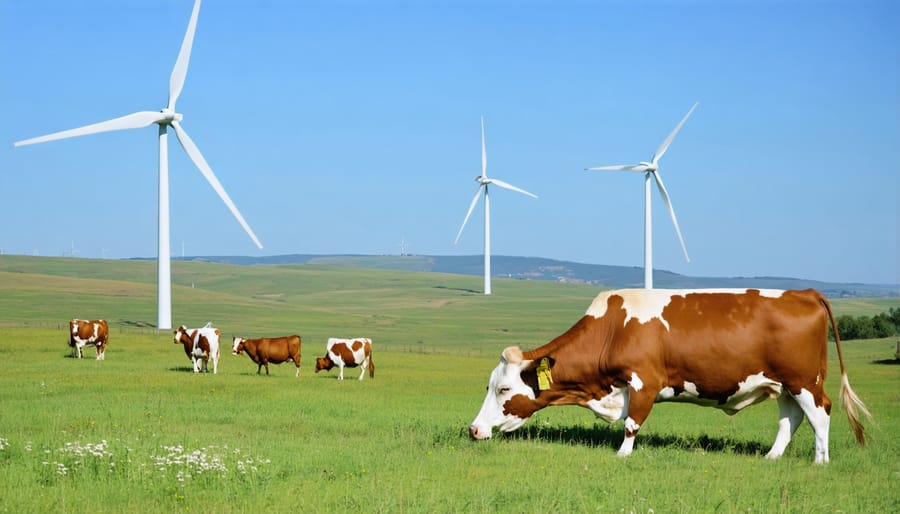
Wind Power Integration Strategies
In Alberta’s diverse landscape, integrating wind power into farming operations requires careful planning and strategic implementation. Many farmers have found success by starting with a detailed wind resource assessment, typically conducted over 12 months, to determine optimal turbine placement. Local success stories, like the Henderson family farm near Pincher Creek, demonstrate how proper positioning can yield up to 60% of a farm’s energy needs through wind power.
For most Alberta farms, small to medium-sized turbines ranging from 10 to 50 kW are ideal. These units can be installed without major infrastructure changes and typically require about 0.1 hectares of land per turbine. During peak harvest seasons, these systems can offset significant power costs, with many farmers reporting savings of $3,000 to $5,000 annually.
The key to successful integration lies in proper maintenance scheduling. Many Alberta farmers coordinate turbine maintenance with their regular equipment maintenance routines, typically in early spring before seeding. This approach has proven particularly effective for operations in wind-rich regions like southern Alberta, where average wind speeds exceed 6 metres per second.
Battery storage systems are becoming increasingly popular among wind power adopters. Modern storage solutions allow farms to maintain consistent power supply during low-wind periods, with many systems providing up to 48 hours of backup power. Local agricultural cooperatives often share resources and expertise, making implementation more cost-effective for smaller operations.
Hybrid Systems: Getting the Best of Both
Combining wind and solar power on your farm isn’t just about doubling down on green energy – it’s about creating a reliable, year-round power system that works with Alberta’s diverse weather patterns. When the winter winds are howling across the prairies, your turbines are working overtime, and during those long summer days, your solar panels are soaking up the sunshine. This complementary relationship is what makes hybrid systems one of the most effective sustainable farming solutions available today.
Take the Mackenzie family farm near Red Deer, for example. They installed a 10kW wind turbine alongside a 15kW solar array, reducing their annual energy costs by 75%. During peak farming seasons, they’re often producing surplus power they can sell back to the grid.
The key to success is right-sizing your system. Most Alberta farms find that a combination of 60% solar and 40% wind capacity provides optimal year-round coverage. This split accounts for our region’s seasonal patterns while maintaining steady power generation.
Storage solutions are crucial for hybrid systems. Modern battery banks can store excess energy from both sources, ensuring you have power when you need it most. While the initial investment might be higher than single-source systems, the increased reliability and efficiency typically result in faster payback periods – usually between 7-10 years under current incentive programs.
Real Success Stories from Alberta Farms
The Peterson Family’s Solar Journey
Fourth-generation farmers Mark and Sarah Peterson of Sundre, Alberta, represent one of the region’s most inspiring solar power success stories. In 2019, they installed a 10-kilowatt solar array on their 400-hectare organic grain operation, transforming their energy consumption patterns and reducing operational costs.
The Petersons’ initial investment of $28,000 was offset by a $7,000 provincial rebate, making the project more financially accessible. Within the first year, they observed a 65% reduction in their electricity bills, with the system generating enough power to run their grain drying equipment and workshop facilities during peak summer months.
“We were spending nearly $4,800 annually on electricity before solar,” explains Mark. “Now we’re looking at around $1,700, and during summer months, we often generate surplus power that goes back to the grid.”
The installation process took just four days, with minimal disruption to farm operations. The Petersons worked with local contractors who understood agricultural requirements and Alberta’s climate conditions. They positioned the panels to maximize exposure during harvest season when energy demands are highest.
The system’s durability has exceeded expectations, withstanding severe hailstorms and maintaining consistent performance through extreme temperature fluctuations. Regular maintenance consists of simple panel cleaning twice yearly, typically coinciding with other routine farm maintenance schedules.
Wind Power Success at Rocky Ridge Ranch
Located just outside of Pincher Creek, Alberta, the Rocky Ridge Ranch’s transition to wind power stands as a shining example of successful renewable energy integration in agricultural operations. Third-generation farmer Sarah Thompson made the bold decision in 2019 to install three 50kW wind turbines on her 800-hectare cattle ranch, and the results have exceeded expectations.
“The constant winds in our region made wind power an obvious choice,” explains Thompson. “We’re now generating enough electricity to power our entire operation, including the barn, irrigation systems, and processing facility, with surplus energy being fed back into the grid.”
The installation, which cost $425,000, was partially offset by Alberta’s Renewable Energy Credit program, reducing the initial investment to $297,500. Thompson reports that the system paid for itself in just under four years through energy savings and grid feed-in credits, averaging $74,000 in annual benefits.
The success wasn’t without challenges. Thompson worked closely with local wildlife experts to ensure minimal impact on bird populations and collaborated with neighboring farms to address initial concerns about visual impact. The turbines were strategically placed to maximize wind exposure while minimizing disruption to farming operations.
Today, Rocky Ridge Ranch serves as a learning hub for other Alberta farmers interested in wind energy integration, hosting monthly tours and sharing detailed performance data with the local farming community.
Cost Analysis and Available Support
Investment and Returns
Initial investments in renewable energy systems vary based on farm size and energy needs, but most Alberta farmers can expect to invest between $20,000 to $75,000 for a basic solar installation. Wind turbine systems typically range from $40,000 to $120,000, depending on capacity. However, these costs are often offset by provincial and federal green energy grants, which can cover up to 30% of the initial investment.
The return on investment typically occurs within 7-10 years, with solar panels lasting 25-30 years and wind turbines 20-25 years. Many farmers report annual energy savings of $3,000 to $8,000, with some generating surplus power they can sell back to the grid through Alberta’s micro-generation program.
Local farmer Mike Thompson from Lacombe County shares, “Our 40kW solar system cost $65,000 after grants, but we’re saving $6,500 annually on electricity. Plus, we’re protected against future energy price increases.” Additional benefits include increased property value and potential carbon credit earnings through Alberta’s carbon offset system, making renewable energy a sound long-term investment for farm operations.
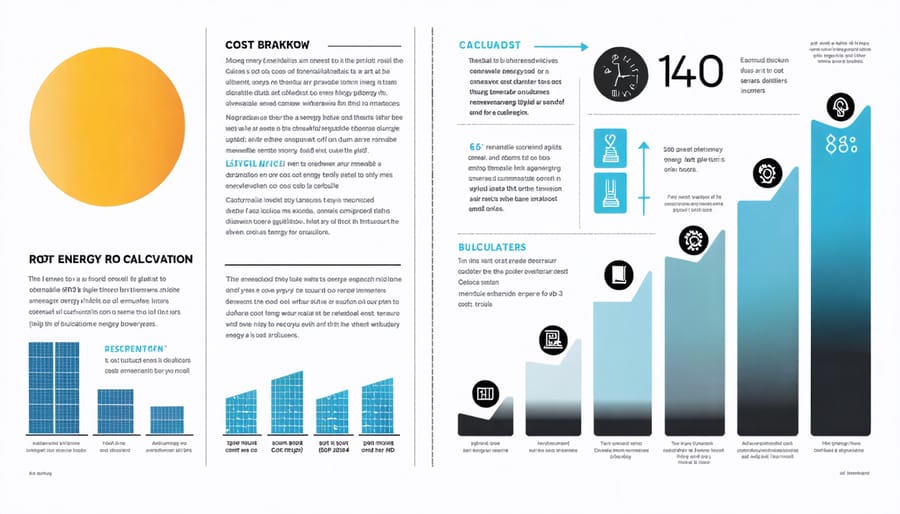
Alberta’s Green Energy Programs
Alberta farmers can access several provincial programs supporting the transition to renewable energy. The Emissions Reduction Alberta (ERA) program offers grants covering up to 50% of project costs for on-farm solar installations and wind energy systems. For smaller operations, the On-Farm Energy Management Program provides cost-sharing opportunities of up to $50,000 for energy efficiency upgrades and renewable energy projects.
To access these programs, farmers need to complete an initial energy assessment through a qualified professional. Local agricultural fieldmen can help connect you with certified assessors and guide you through the application process. The Alberta Agriculture and Irrigation department also offers free workshops throughout the year to help farmers understand program requirements and develop strong applications.
Additional support is available through the Canadian Agricultural Partnership (CAP), which provides funding for environmental sustainability initiatives. Many rural municipalities have partnered with local utilities to offer supplementary incentives and technical assistance for renewable energy projects.
Remember to check application deadlines and eligibility criteria, as programs are regularly updated. Your local Agricultural Service Board can provide the most current information and application support.
As we’ve explored throughout this article, integrating renewable energy into Alberta’s farming operations isn’t just an environmental choice – it’s a smart business decision that can strengthen our agricultural communities. The successful examples we’ve seen from local farmers demonstrate that solar panels, wind turbines, and biomass systems can significantly reduce operational costs while maintaining or improving farm productivity.
Remember, you’re not alone in this journey. Alberta’s agricultural community is known for its innovative spirit and willingness to support fellow farmers. The available grants, tax incentives, and technical support programs make now an ideal time to explore renewable energy options for your farm.
Whether you’re considering a small solar installation to power your irrigation system or a comprehensive wind energy solution for your entire operation, start by assessing your farm’s energy needs and renewable resource potential. Connect with local agricultural extension offices, renewable energy consultants, and fellow farmers who have already made the transition.
Taking the first step toward renewable energy integration might seem daunting, but the long-term benefits for your farm, community, and future generations make it worthwhile. As stewards of the land, we have the opportunity to lead by example in sustainable agriculture practices while building more resilient and profitable farming operations.
Consider reaching out to your local agricultural association or renewable energy cooperative to learn more about how you can begin your farm’s renewable energy journey today.




